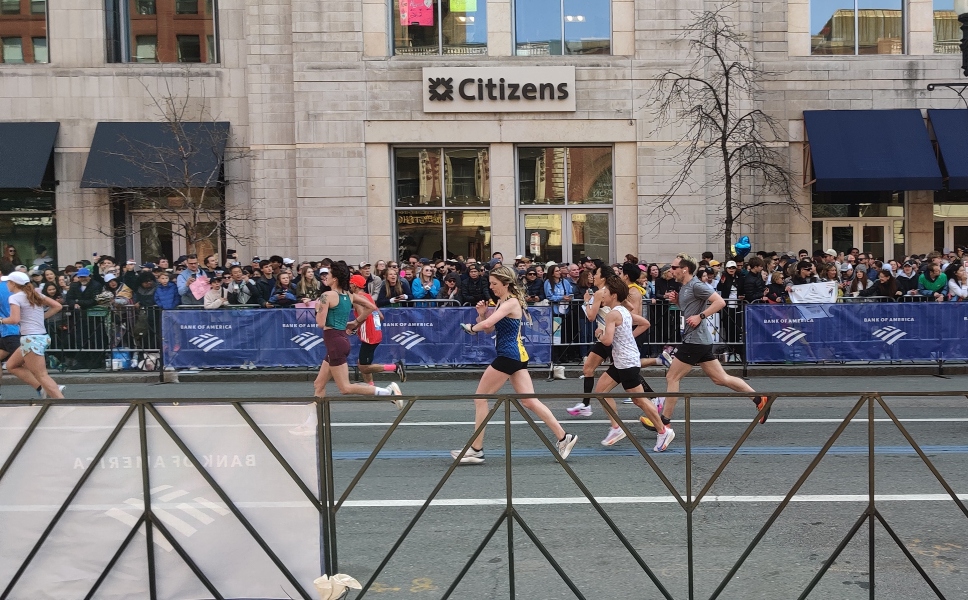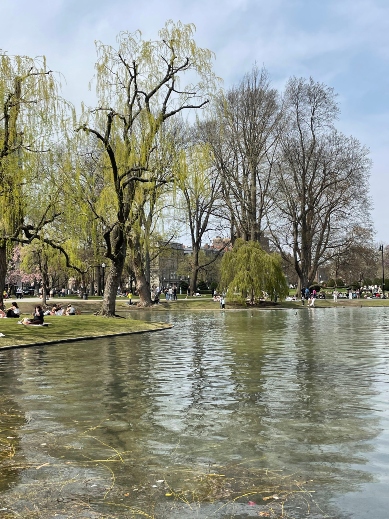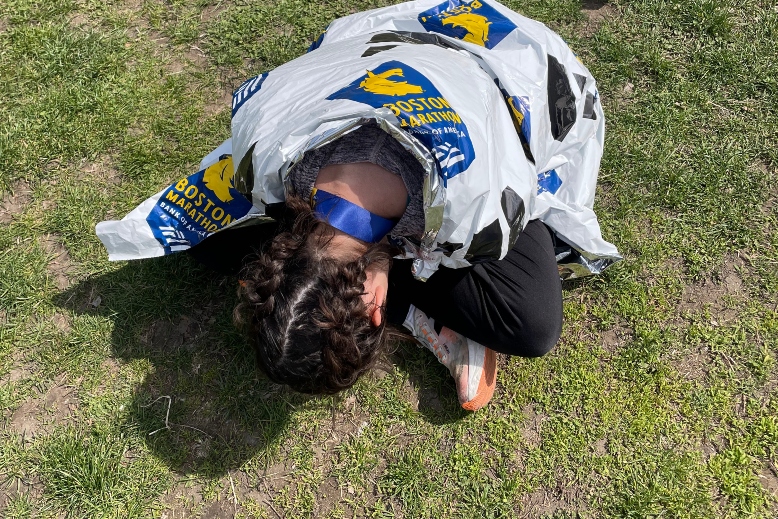Running the Boston Marathon was one of my longest-standing running goals. I hit my goal last year and had a very successful trip. Yet, there are things I would do differently if I were to go back, and I also wish there had been a more streamlined guide to Boston. I had to do a lot of googling, and still, not all my questions were satisfactorily answered.
This guide is intended for first-time Boston Marathon runners and spectators. I’m compiling not just my knowledge, but the advice of my entourage (aka my mom, sister, mother-in-law, and husband).

Book Flights and Hotels
One of the most nail-biting parts of the Boston Marathon is not knowing what the exact cutoff time will be. I can’t provide any insight into that particular aspect of Boston, but I can reassure you that if you wait to book everything until after you know you qualify, you’ll be okay.
Registration for the 2026 Boston Marathon is open from September 8th to September 12th, 2025. You can start booking your hotel and flight upon receiving your entry confirmation. I did so without issue, though you may not snag one of the most coveted locations for your hotel.
Hotels can be very expensive for this trip. We booked our room at the DoubleTree by Hilton in Bayside. It’s not the closest to either the start or finish, but that’s okay. If you don’t book a hotel that’s close to either of those locations, try for a hotel that’s close to a subway station.
Many hotels also offer transportation to and from the airport, although you may need to book your complimentary ride in advance. You should also consider bringing cash as a tip. Our shuttle driver gave us an excellent mini-tour of Boston and answered our questions.
Also, beware lookalike shuttles. We saw several DoubleTree vans and nearly got on the wrong one. Make sure you know which hotel you are staying at!
Between the hotel shuttle (which also offered rides to other nearby locations upon request) and the public transportation, it was unnecessary to book a car. It would have been too much of a hassle, and we wouldn’t have seen nearly as much of Boston if we had rented one. So, unless you are staying very far away, I don’t recommend renting a car.

If you are near the Boston Common and Public Garden or can easily get there, you’re good to go.
How Long Should You Stay in Boston?
While there are tons of factors to consider when deciding how long your Boston trip should be, let’s pretend it’s entirely up to you. (Not your available PTO, other obligations, or financial constraints).
We got to Boston late on the Thursday before the race and left early on Wednesday after the race. While there were plenty of things to do in Boston that we did not have time for, this time frame felt perfect for me. I wanted to do as many of the marathon-specific activities as possible, and my trip lined up well with the events and pop-ups.
If you want to take in more of the historical sites around Boston and spend more time on your feet, I recommend giving yourself more time after your race. I had to limit myself on the weekend leading up to the race to prevent my legs from becoming too fatigued.
Though I gave myself a daily step count limit, I still ended up with a slight twinge in my IT band from all the extra walking. Fortunately, it didn’t bother me during the race. When planning your trip, account for all the extra walking you will do, and schedule as many activities after your race as possible (if you are capable of walking afterwards!).
Marathon Events and Pop-ups vs History and Sightseeing

My sister and I pictured at the Puma pop-up, where we tested the Puma Fast-R Nitro Elite 3.
I live, eat, and breathe running. Not only that, I love trying new running gear, whether that’s buying new clothes, test-driving new shoes, or tasting fuel and hydration samples. A core part of my Boston Marathon experience was going to as many group runs and brand activations as possible. I like sightseeing, but I’m not much of a history buff.
To take advantage of the various events and pop-ups, look online for a schedule. I found a few sites that had the inside scoop, and the subreddit for the marathon was also very helpful.
If you are interested in history and Boston itself, there are loads of things to do. I split off from my family to go to running events while they toured Boston. At the top of their list of things to do was to go to Cheers in Beacon Hill and to see the Beacon Hill neighborhood.

Physics by Pierre Puvis de Chavannes is a piece featured in the Boston Public Library, one of my favorite stops.
Regardless of what type of activities you want to do while in Boston, be sure to ration your steps if you are racing on Monday. Saturday and Sunday, I gave myself an allowance of 14,000 steps and stuck to it.
Expo
The Boston Marathon Expo took up a significant amount of time. I went to the Expo on Friday, which was much less crowded than the following days. I recommend going as early as you can to beat the crowd, especially if you want to make any purchases at Adidas, Boston’s official sponsor. It takes hours to get through the checkout line.
Make sure you have your ID on you when you go to pick up your bib and shirt. The expo separates participants from the rest of the public, and I realized too late that I had handed off my wallet to my husband. It can be chaotic and overwhelming inside, so be as prepared as possible.
After picking up my bag and buying a top from Adidas, I was in and out of the rest of the expo pretty quickly. The rumors that the Boston Marathon Expo isn’t what it used to be are true. You will find most of the popular running brands running events outside of the expo, though it is worth doing a quick perusal of the rest of the booths.
Food
There are tons of great places to eat in Boston. Plan ahead to beat the crowds and to prevent yourself from trekking back and forth all over the city from food to events. A good plan can help you minimize your steps, preserving those legs for race day!
Since I arrived in Boston days ahead of the race, my first priority was to find a place I could reliably eat without any stomach issues. I settled on Veggie Galaxy, as I’m vegan, and it had tons of carbohydrate-rich menu items to choose from. We ate there at least three times, and I took leftovers back to my hotel to eat before the race.
While eating from the same place is less exciting than trying all the options in a city, it’s safer. I had a terrible experience before and during my qualifying marathon, the Rock’n’Roll San Diego Marathon. I lost three minutes to the porta potty, and I was determined not to make a similar mistake in Boston.
My sister’s must-have dish in Boston was the lobster roll, which she had at Joe’s Waterfront. The view there was spectacular. We ate at slightly odd hours to avoid the crowds, which worked great. The only spot that had a significant line was my favorite, REDWHITE BONELESS RAMEN. We went twice, and I highly recommend it. The portion sizes were fantastic for refueling after the race!
Race Day
I felt a little overwhelmed on Monday morning. It took all of my focus to get into a good mindset and relax, as getting to the Boston Marathon starting line was unlike any other race I’ve participated in.
I left the hotel just before 6:30 AM to catch the train to Boston Commons, where the buses pick you up. I’d scoped out the pickup area during the previous days to ensure I knew where to go. The biggest mistake I made on race day was not realizing I needed to walk a ways to get to the gear check.
Give yourself plenty of time to get to gear check (if you have anything to drop off) and get to the buses. You can only take the smaller bag, designated as the Start Area Bag, on the bus. Anything that you are not carrying during the race has to be thrown away or placed in one of the donation bins before you get to the starting line.

I tried to keep calm while my sister was already possessed by the energy of the day.
It’s hard to know what the weather will be like on marathon day. I was fortunate to have pretty much perfect conditions for 2025. That meant it was cool, and I needed warm-ups to cover my race uniform. I brought an old sweatshirt and pants from home that I was planning to donate. You won’t get these clothes back, so now isn’t the time to show off. I saw some pretty expensive brands being stripped off, and I felt physically sick!
The same rule goes for any other gear you bring. I brought extra water and snacks, which is important. However, be ready to toss it in the bin. The time passed faster than I expected, so I had to ditch more than I expected, but it’s better than feeling like you don’t have enough. The bus takes up a lot of time, so you won’t be at the Athletes’ Village for too long. I used the time to do my warm-up drills.
Using the bathroom before the race was more stressful than I expected. There are bathrooms once you start the walk to the starting line, but you need to be quick. I suggest running to the furthest lines as quickly as possible.
Sunscreen is also handed out along the walk to the starting line. It’s a good opportunity to slather some on and protect your skin.
You can keep your warm-ups, snacks, and water while on the walk. There are bags and bins to stash them in when you decide it’s time to give them up.
The Race
Negative splits are difficult to accomplish in Boston due to the downhill start of the race and the late-race hills. The race course is also a bit crowded, not so crowded that you get too boxed in, but I did end up tacking some extra distance on weaving around groups of other runners.
Aid stations line both sides of the course, so try to minimize the amount you weave back and forth by sticking to one side. That can be hard to do, but it’s easier if you know what to expect. Getting your hydration and fuel from further down the table can help reduce the time you spend at aid stations, as some runners stop or walk, particularly toward the start of the tables.
I opted to just let my legs fly at the start of the race, taking advantage of the downhills and banking some time. I think the strategy worked for me because I was so unsure of what a realistic goal time would be for me, but if you are more confident in your pacing, be more conservative and traditional in your pacing.
The Newton Hills, including the infamous Heartbreak Hill, were not as terrifying as I had heard. While I certainly slowed down and had to consciously work to break away from groups of slower runners, I felt prepared to tackle them. My two prior marathons, Rock’n’Roll San Diego and the St. George Marathon, had tougher hills, so if you’ve already run a hilly course or incorporated hills into your training, you can do it. Let the crowd’s support carry you through it!
That brings me to the highlight of the race: the crowd’s energy. While there are lulls in the chaos, the cheering really carried me through the race. Though I typically run with music, I didn’t miss having it during the Boston Marathon. My experience was truly better without it, though I had some initial reservations about leaving my phone and headphones behind.

By the end of the race, I was ready to collapse anywhere.
Spectating
My family was anxious about having a good view of the finish line, so they got there around 8 AM. There wasn’t nearly as much competition for a good spot, so they spent a lot of time just waiting around. If you want to spectate at the finish line, they suggested arriving around 9 AM or a little later.
If you plan to view the race at another location, you’ll have to plan ahead, taking road closures and traffic into account. Most spots along the course aren’t so packed that you will be fighting for a spot. You just want to make sure that you give yourself plenty of time to get there.
Whether you are spectating close to the finish line or further away, plan a route from your location to a designated meeting point with your athlete.
They also recommended reviewing the list of prohibited items. Boston wants to keep everyone safe, and it’s important to do your part.
The Finish Line and Family Meeting Area
I didn’t carry my phone during the race or store it at gear check, but I knew my family planned on being near the finish line, so it wouldn’t take them too long to find me once I finished. There is also a family meeting area where you can find your loved ones. It takes a while to get through the finish line shoot and gear check, giving your family time to get through the crowd.
If you need medical attention (or look like you need it), help is available after the finish line.
You also get your medal at the finish line!
Post-Race Activities
I spent the rest of race day lounging in my room. I think the walk from the finish line to the subway and to the hotel helped loosen up my legs, but I was also thankful for the rest.
The next day, there are plenty of post-race activities going on. I made the mistake of not wearing my medal around. It’s been ingrained into me not to be boastful about running, like talking about my times or wearing my medal around. These manners go out the window the day after Boston. Wear your medal proudly and take advantage of one of the medal engraving events. I missed out, and I regret this mistake the most!

Boston is beautiful in the spring, so it’s a great time to enjoy the area.
After Boston, it’s time to enjoy the city as much as you can. The movement really helped my legs, but the excitement eventually caught up to me, and I found myself needing more rest.
Frequently Asked Questions
Is Boston a tough marathon?
The Boston Marathon is a tough marathon due to the initial downhill start and Newton Hills spanning the course from about mile 16 to mile 21. These late-race hills can be difficult to tackle when your quads are already fatigued from the pounding of running downhill. However, it is not impossible to run a personal best during the Boston Marathon.
Is there a way to run the Boston Marathon without qualifying?
The Boston Marathon is open to charity runners, in addition to those who have qualified by time. To run for a charity, you will have to apply to the participating charities and commit to the fundraising minimum. This minimum is typically around $10k.
How much does it cost to run the Boston Marathon?
The Boston Marathon entry fee is $250, charged when you are accepted into the race. Your card will not be charged until it’s official, so don’t worry about having to pay if you don’t get in.
For one runner and a guest, my Boston Marathon stay cost just under $3500. That included our flights, a hotel for six nights, food, the race entry fee, and public transportation. You could reduce that price by staying for a shorter time. I also recommend factoring in the cost of any souvenirs or shopping you might do, as well as any event tickets you might pay for.
You can certainly spend less, with some runners claiming to spend $1000 all in, though others pay $3000 just for one person.


Leave a Reply